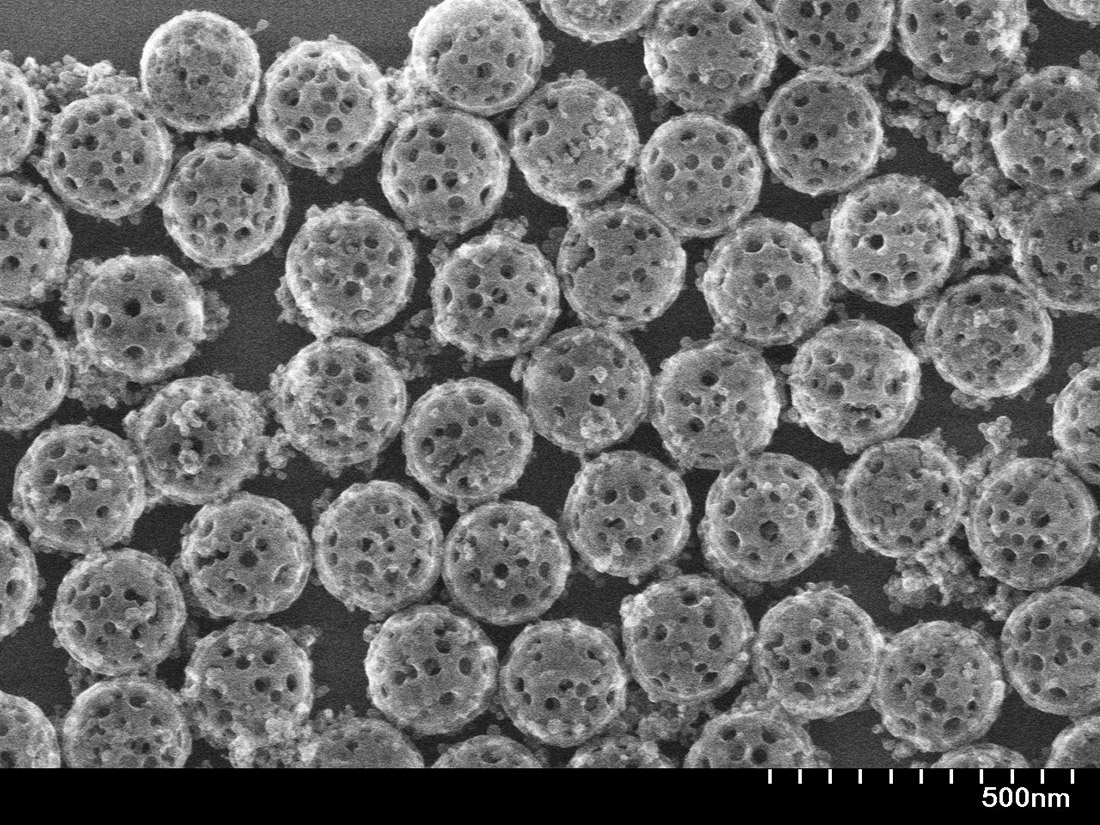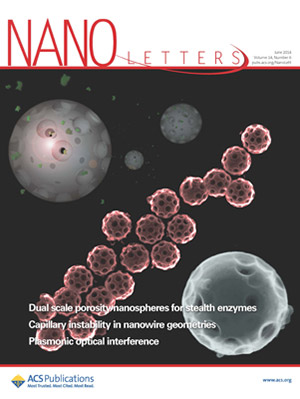
Nanoshell Shields Foreign Enzymes Used to Starve Cancer Cells from Immune System
Published Date
By:
- Catherine Hockmuth
Share This:
Article Content

The enzymes are loaded into the nanoparticle very efficiently through pores on its surface and later encapsulated with a shell of nanoporous silica. The shell’s pores are too small for the enzyme to escape but big enough for diffusion of amino acids that feed cancer cells in and out of the particle. The enzymes remain trapped inside where they deplete any amino acids that enter. Photo courtesy of Inanc Ortac.
Nanoengineers at the University of California, San Diego have developed a nanoshell to protect foreign enzymes used to starve cancer cells as part of chemotherapy. Their work is featured on the June 2014 cover of the journal Nano Letters.

Nanoengineers at the University of California, San Diego have developed a nanoshell to protect foreign enzymes used to starve cancer cells as part of chemotherapy. Posted with permission from Nano Letters, June 2014, 14(6). Copyright 2014 American Chemical Society.
Enzymes are naturally smart machines that are responsible for many complex functions and chemical reactions in biology. However, despite their huge potential, their use in medicine has been limited by the immune system, which is designed to attack foreign intruders. For example, doctors have long relied on an enzyme called asparaginase to starve cancer cells as a patient undergoes chemotherapy. But because asparaginase is derived from a nonhuman organism, E. Coli, it is quickly neutralized by the patient’s immune system and sometimes produces an allergic reaction. In animal studies with asparaginase, and other therapeutic enzymes, the research team found that their porous hollow nanoshell effectively shielded enzymes from the immune system, giving them time to work.
Asparaginase works by reacting with amino acids that are an essential nutrient for cancer cells. The reaction depletes the amino acid, depriving the abnormal cells from the nutrients they need to proliferate.
“Ours is a pure engineering solution to a medical problem,” said Inanc Ortac (Ph.D. ’13), who developed the technology as part of his doctoral research in the laboratory of nanoengineering professor Sadik Esener at UC San Diego Jacobs School of Engineering.
The nanoshell acts like a filter in the bloodstream. The enzymes are loaded into the nanoparticle very efficiently through pores on its surface and later encapsulated with a shell of nanoporous silica. The shell’s pores are too small for the enzyme to escape but big enough for diffusion of amino acids that feed cancer cells in and out of the particle. The enzymes remain trapped inside where they deplete any amino acids that enter.
"This is a platform technology that may find applications in many different fields. Our starting point was solving a problem for cancer therapeutics,” said Ortac.
Ortac is currently serving as the chief technology officer of DevaCell, a local start-up which licensed the technology and is working to commercialize it under the name Synthetic Hollow Enzyme Loaded nanoShells or SHELS. Ortac, together with graduate student Ya-san Yeh, recently took the top prize at Research Expo 2014 at UC San Diego Jacobs School of Engineering. Yeh discussed her role in the project in our video linked below. Ortac also won first place in the Collegiate Inventors Competition in 2012 and UC San Diego Entrepreneur Challenge in 2013 with a business plan based on the technology. Just recently, San Diego Business Journal recognized the researchers with the 2014 Innovation Award in Medical Research.
Share This:
You May Also Like
Stay in the Know
Keep up with all the latest from UC San Diego. Subscribe to the newsletter today.


